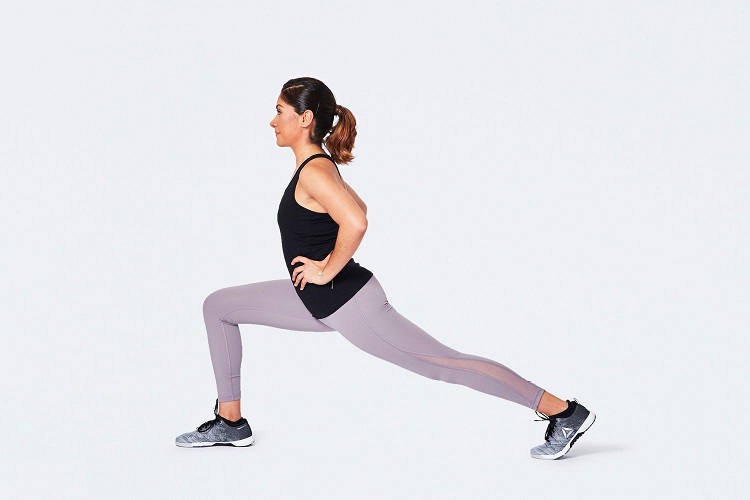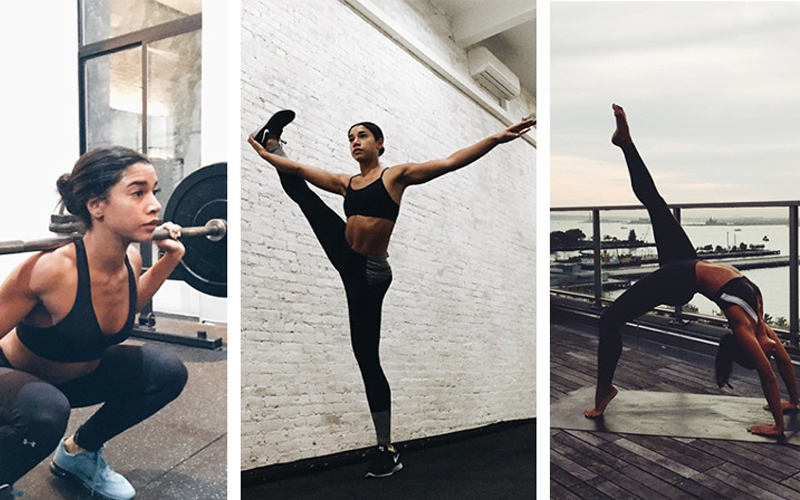Fascial stretching is designed to improve the suppleness and durability of your tissues, all at once. This technique incorporates gentle, pulsating movements that exude a sense of playfulness and lightness rather than rigidity. The fluidity of the movements creates a seamless flow, almost resembling a gentle rocking motion, making it a unique and effective way to care for your body.
Stretches to try
Utilize these stretches to alleviate tightness and tension in your fascia. Stretch until you feel a gentle sensation, avoiding any straining or forceful movements to achieve the position. Prioritize a mindful and controlled approach to ensure safety and effectiveness.
1) Downward-Facing Dog:

Practice Downward-Facing Dog to invigorate your energy or unwind after a long day. This yoga pose not only strengthens your entire body but also helps relieve pain, tightness, and tension.
Here’s how to do it:
- Start in a tabletop position with your hands and knees on the ground.
- Spread your fingers wide and evenly press into both palms.
- Lift your hips upward while slightly bending your elbows and knees.
- Gently raise your heels off the ground, maintaining a slight bend in your knees to prevent over-straining.
- Elongate your spine and ensure your head is relaxed by tucking your chin toward your chest.
- Hold this pose for up to 1 minute, allowing yourself to find a comfortable and steady position.
2) Standing hip flexor stretch:

This stretch is effective for counteracting the effects of prolonged sitting. It aims to loosen and elongate your hip flexors, leading to improved posture and pain relief.
To ensure stability and support, you can place your opposite hand on a wall, table, or chair.
Follow these steps:
- Shift your weight onto your left foot.
- For balance, press into your big toe and fix your gaze on a steady point.
- Bend your right knee and draw your heel towards your glute.
- Use your right hand to grasp your right ankle.
- Maintain a slight bend in your left knee, engaging your core and glute muscles, while keeping your spine elongated.
- Bring your right knee down and toward the center of your body.
- Place your opposite hand on your hip, extend it back to your ankle, or stretch it overhead for added balance and sensation.
- Hold this position for up to 1 minute, allowing your body to adjust and relax.
- Repeat the entire sequence on the opposite side for balanced stretching benefits.
3) Standing figure-four stretch:

This stretch is beneficial for elongating the hip flexor muscles and relieving tightness in the back, core, and glutes.
To maintain balance and support, you can place your hand on a wall, table, or chair.
Here’s how to do it:
- Shift your weight onto your left foot.
- Find balance by pressing into your big toe and fixing your gaze on a steady point.
- Take your right ankle and place it on your lower left thigh from the outside.
- Keep your hips squared, facing forward, and elongate your spine while lifting your chest.
- Bend your left knee, lowering your hips into a squatting position.
- Hold this posture for up to 1 minute, feeling the stretch and allowing your body to adapt.
- Repeat the entire sequence on the opposite side for balanced stretching benefits.
4) Extended Side Angle Pose:

This yoga pose offers a complete stretch along the side of your body and hips while simultaneously building strength.
To incorporate a gentle neck stretch, exhale as you rotate your neck to gaze downward, and on the inhale, look upward towards the ceiling. Repeat this motion ten times while keeping the rest of your body stable, focusing solely on your neck movement.
Follow these steps:
- Position your feet apart by jumping, stepping, or walking.
- Turn your left toes forward and angle your right toes slightly outward.
- Align your left heel with the inside of your right foot.
- Bend your right knee, ensuring it remains above your ankle without surpassing it.
- Hinge your hips forward and place your left hand on the floor or a block inside your left foot. Alternatively, rest your elbow on your lower thigh, with your fingers pointing towards the center and your palm facing upward.
- Reach your right fingertips outwards while maintaining firm pressure on both feet.
- Hold this pose for up to 1 minute, feeling the stretch and engaging your muscles.
- Repeat the entire sequence on the opposite side, creating balance in your stretching routine.
5) Foam rolling for the upper back:
To perform this tension-relieving movement that enhances your upper back and promotes better posture and alignment, you’ll need a foam roller.
Here are the steps:
- Lie on your back, placing the foam roller under your head, spine, and tailbone for support.
- Bend your knees and firmly press your feet into the floor.
- Extend your arms out to the sides, with your palms facing upward.
- Engage in deep abdominal breathing, allowing your body to relax fully.
- Hold this position for up to 1 minute, feeling the soothing effects on your upper back.
- For added benefit, you can repeat this sequence 1 to 3 times.
6) Foam rolling for the low back:
For this exercise that targets tightness, releases muscle knots, and enhances range of motion, you’ll require a foam roller.
Here’s how to perform it:
- Lie on your back, positioning the foam roller horizontally below your low back.
- Draw your knees into your chest.
- Place your hands behind your thighs or on your shins for support.
- Slowly roll over to the right side.
- Lift the left side of your low back off the foam roller, holding this position for a few seconds.
- Gradually shift to the opposite side, holding the position for a few seconds as well.
- Continue moving from side to side in a controlled manner for up to 1 minute.
- For additional benefits, you can repeat this sequence 2 to 3 times.
The bottom line
In order to keep your fascia flexible and healthy, it’s crucial to establish a regular stretching and joint mobility routine. The stretches provided above can serve as a foundation for creating a personalized routine tailored to your body and requirements.
Remember to incorporate ample physical activity into your daily life and prioritize sufficient time for rest, relaxation, and quality sleep. By dedicating yourself to enhancing your fitness level and overall well-being, you can experience improved feelings of well-being and performance. Embrace this commitment to lead a more active and fulfilling lifestyle.
See also How to Relieve Sore Muscles and Muscle Pain After Exercise




